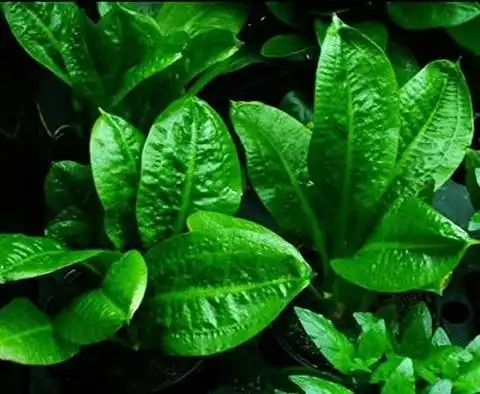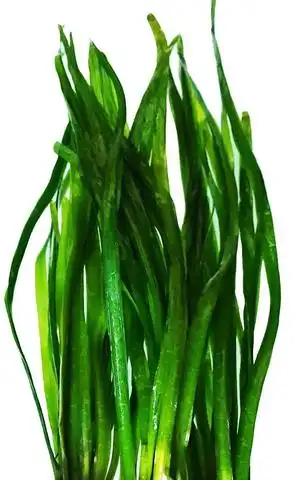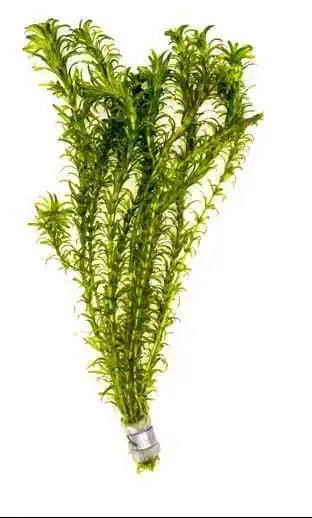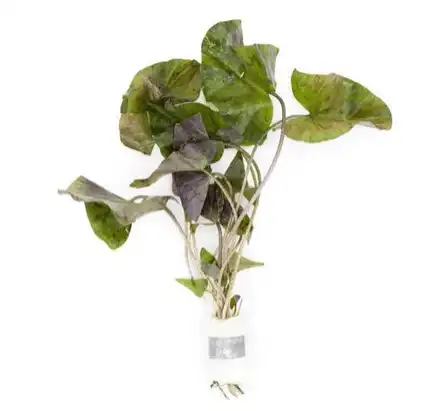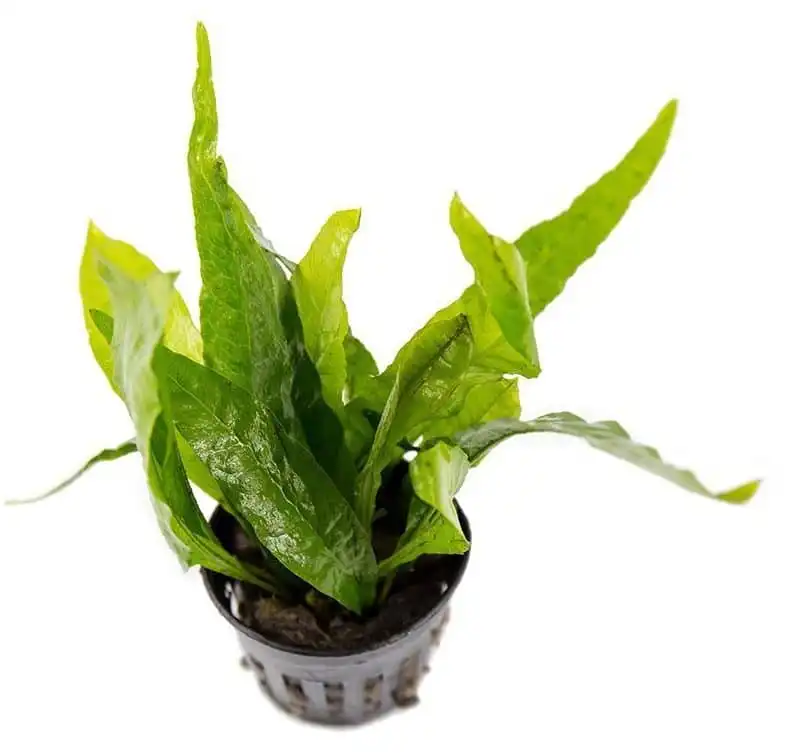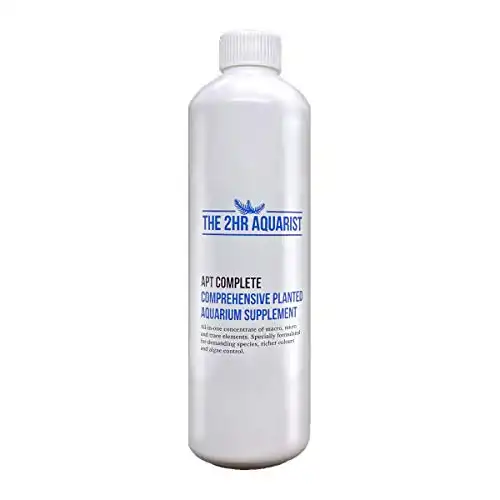Thank you for visiting! By the way… any links on this page that lead to products on Amazon and other stores/partners are affiliate links Aquarium Store Depot earns a commission if you make a purchase.
Have you considered adding some lush green growth to your fish tank? Tall aquarium plants are ideal for the background of freshwater aquariums, but they also make great features for the middle of larger tanks. In this guide, I’ll be introducing 15 excellent species that you can grow in your own tank.
I’ll also dive into some of the benefits of growing aquarium plants and cover some helpful tips on how to keep them alive and thriving. Let’s get started!
Key Takeaways
- Some examples of tall aquarium plants include Amazon Sword, Water Wisteria, Vallisneria, Cabomba, and Hornwort
- Tall aquarium plants are ideal for the background of the aquarium because they can create a ‘living wall’ that adds depth and hides cables, hardware, and other stuff behind the tank.
- Most tall aquarium plants grow rooted in the substrate, but some can be attached to the hardscape.
- Many tall aquarium plants grow fast with minimal care, but some prefer bright light, added CO2, or specific water temperatures and pH levels. Research each plant before planting it in your tank to make sure it will be a good fit.
15 Tall Aquarium Plants
Are you ready to learn about 15 awesome tall aquarium plants? Each of these hand-picked choices can grow to over a foot tall under the right conditions (video source from our Channel), just make sure to compare their light and care requirements to make the best choice for your tank.
1. Amazon Sword
A classic background aquarium plant. Grows large and will be a centerpiece in your aquarium
- Scientific name: Echinodorus sp.
- Family: Alismataceae
- Origin: Brazil
- Difficulty: Easy
- Light: Moderate
- Substrate requirement: Yes
- Fertilizer type: Root tabs/ aquarium soil
- CO2 requirement: No
Amazon Sword is a beautiful rosette plant that grows rooted in the substrate. This tall, large-leaved plant is a popular choice for the background of medium-sized tanks, although it can be used in the mid-ground of larger aquariums.
Amazon swords are great for beginners because they grow at a fast but manageable rate and do not need high lighting conditions or carbon dioxide. Choose these sword plants for a dense, tropical look in your freshwater aquarium.
2. Water Wisteria
An easy to grow and great beginner floating plant to try!
- Scientific name: Hygrophila difformis
- Family: Acanthaceae
- Origin: Asia
- Difficulty: Easy
- Light: Low/moderate
- Substrate requirement: Recommended
- Fertilizer type: Liquid
- CO2 requirement: No
Water wisteria is a fast-growing plant that can be rooted in the substrate or allowed to float in the water column. Its leaves have great texture and interesting roots grow from the nodes to collect nutrients from the water column. This bright green plant makes a great background plant if planted in groups at the back of the tank.
3. Vallisneria Spiralis
One of the easiest background placement aquarium plants that can be kept. Provides excellent shelter for fish
- Scientific name: Vallisneria spiralis
- Common names: Straight vallisneria, tape grass
- Family: Hydrocharitaceae
- Origin: Europe, Africa, and Asia
- Difficulty: Moderate
- Light: Moderate/high
- Substrate requirement: Yes
- Fertilizer type: Root tabs/ aquarium soil
- CO2 requirement: Recommended
Straight Vallisneria is an excellent background plant for medium-sized aquariums since it grows to about 2 feet tall. This plant will not grow up out of the water in shallow tanks but rather bend over to grow along the surface, creating a very attractive effect.
Vallisneria grows rooted in the substrate and should be grown in a fertile substrate to do its best. It grows fast and does require some maintenance since it spreads across the bottom by runners.
4. Vallisneria Americana
A very tall background plant that needs a deep substrate and fertilizers to thrive
- Scientific name: Vallisneria americana
- Common names: Jungle val, wild celery, tape grass
- Family: Hydrocharitaceae
- Origin: Asia, Australia, South and North America
- Difficulty: Moderate
- Light: Moderate
- Substrate requirement: Yes
- Fertilizer type: Root tabs/ aquarium soil
- CO2 requirement: Recommended
Vallisneria americana is a tall aquarium plant that grows to about three feet in a nutrient rich substrate. Its bright green leaves may be straight or twisted but are strap-like and extend upwards toward the water’s surface.
Jungle val is an excellent choice for the background of a large aquarium and can even survive in slightly brackish water.
5. Cryptocoryne Balansae
An easy to grow Crypt plant that does not grow fast. Unique textures make for a good background plant
- Scientific name: Cryptocoryne crispatula
- Family: Araceae
- Origin: Thailand
- Difficulty: Easy/intermediate
- Light: Moderate/high
- Substrate requirement: Yes
- Fertilizer type: Root tabs/aquarium soil and liquid fertilizer
- CO2 requirement: Recommended
Cryptocoryne balansae is an easy aquarium plant for the background of freshwater aquariums. It can reach a height of nearly two feet and has long, narrow leaves with an attractive wavy texture.
This cryptocoryne shows optimum growth under high lighting and does well in good water flow. It is native to areas with naturally hard water parameters but does well in slightly acidic to slightly alkaline conditions. Like other crypts, these plants need stable water conditions to avoid suffering ‘crypt melt’.
6. Cabomba
One of the easier Cabomba plant types available that is suitable for beginners. Can be grown submersed or emersed
- Scientific name: Cabomba aquatica
- Common names: Fanwort, giant cabomba
- Family: Cabombaceae
- Origin: South America
- Difficulty: Moderate
- Light: Moderate/high
- Substrate requirement: Yes
- Fertilizer type: Liquid fertilizer
- CO2 requirement: Recommended
Giant cabomba is a beautiful, fine-textured stem plant with a striking pale green color. It is a hardy plant that can quickly grow to over two feet, although it does best with CO2, regular feeding, and gentle water flow. These are great background plants for larger aquariums with moderate to intense lighting.
7. Elodea (Anacharis)
Excellent as a food source and sucks up nutrients in an aquarium. One of the easiest freshwater plants to care for
- Scientific name: Egeria densa
- Common names: Brazilian waterweed
- Common names: Anacharis
- Family: Hydrocharitaceae
- Origin: South America
- Difficulty: Easy
- Light: Low/moderate
- Substrate requirement: No
- Fertilizer type: Liquid fertilizer
- CO2 requirement: No
Elodea is a very easy tall aquarium plant that is perfect for beginner aquarists. This species has a moderate to fast growth rate and can be grown in both cold water and tropical aquariums. This deep green stem plant looks best when planted in clumps at the back of the aquarium.
8. Hornwort
A tall and easy to grow freshwater plant. One of the least demanding background plants available
- Scientific name: Ceratophyllum demersum
- Common names: Hornwort, coontail
- Family: Ceratophyllaceae
- Origin: South America
- Difficulty: Easy
- Light: Moderate
- Substrate requirement: No
- Fertilizer type: Liquid fertilizer
- CO2 requirement: No
Hornwort is a hardy, fast-growing stem plant that can reach nearly three feet tall under optimal growth conditions. It can grow floating, anchored with weights, or rooted in the substrate and it is excellent for soaking up excess nutrients in the water and outcompeting nuisance algae.
Hornwort is tolerant to both cold and tropical water environments and its fine leaf structure makes a great environment for shy fish and breeding projects.
9. Red Tiger Lotus
The Nymphaea Tiger Lotus is a beautiful flowering plant perfect for any aquarium. This plant is easy to care for and will thrive in most aquariums.
- Scientific name: Nymphaea zenkeri
- Common names: Egyptian lotus, Egyptian water lily
- Family: Nymphaeaceae
- Origin: Africa
- Difficulty: Easy
- Light: Moderate
- Substrate requirement: Yes
- Fertilizer type: Root tabs, aquarium soil, or liquid fertilizer
- CO2 requirement: No
The red tiger lotus is an interesting species that grows from a bulb rooted in the substrate. This beautiful plant has red leaves that grow both in the water and up at the surface.
These surface floating leaves will produce flowers, but many aquarists prefer to trim off the surface growth of the tiger lotus so it doesn’t block out light to the other plants below.
10. Ambulia

- Scientific name: Limnophila sessiliflora
- Common names: Asian Marshweed, Ambulis
- Family: Plantaginaceae
- Origin: Southeast Asia
- Difficulty: Easy
- Light: Low-moderate
- Substrate requirement: Yes
- Fertilizer type: Liquid fertilizer
- CO2 requirement: No
Ambulia is a fast-growing stem plant that reaches a height of about 16 inches (40 cm). It has beautiful, fine-textured leaves but tends to look pretty thin unless planted in bunches.
Fortunately, these beginner friendly background plants are very easy to propagate from cuttings, so you can do a lot with just a few bundles if you have some patience.
11. Bacopa Monnieri
A very hardy tall plant that is appropriate for beginners. Does not require CO2 to survive, but will growth faster with it.
- Scientific name: Bacopa monnieri
- Common names: Moneywort, water hyssop
- Family: Plantaginaceae
- Origin: Australia, Asia, Africa, South and North America
- Difficulty: Easy
- Light: Moderate/high
- Substrate requirement: Yes
- Fertilizer type: Root tabs/ aquarium soil and liquid fertilizer
- CO2 requirement: No
Bacopa monnieri is a bright green, upright aquatic plant with succulent stems. These tall aquarium plants are a great choice for the midground of large aquariums or the background of medium-sized tanks.
Bacopa monnieri can be grown in inert substrates like sand but they do prefer a nutrient-rich substrate and will happily grow above the water’s surface and even produce small white and pink flowers under the right conditions.
12. Ludwigia Natans Super Red
An easy to keep fast growing stem plant. One of the rare red plants that does not require CO2
- Scientific name: Ludwigia palustris
- Common names: Super red ludwigia, water purslane
- Family: Onagraceae
- Origin: Worldwide
- Difficulty: Easy
- Light: Moderate
- Substrate requirement: Yes
- Fertilizer type: Aquarium soil and Liquid fertilizer (preferably high iron for red coloration)
- CO2 requirement: No
Ludwigia Natans ‘Super Red’ is one of the few tall aquarium plants with bright red foliage. This attractive species has a fast growth rate and is ideal for beginner aquarists, although it will not develop its best colors in low aquarium light conditions or if provided with low nutrition.
Grow this plant in a decent aquarium soil and dose regularly with an iron rich fertilizer to encourage that bright red look.
13. Ludwigia Arcuata
- Scientific name: Ludwigia arcuata
- Common names: Needle leaf ludwigia
- Family: Onagraceae
- Origin: North America
- Difficulty: Easy
- Light: Moderate/high
- Substrate requirement: Yes
- Fertilizer type: Root tabs/ aquarium soil and liquid fertilizer
- CO2 requirement: No
The needleleaf ludwigia grows to about 20 inches tall, making it a good choice for the background of a medium or tall aquarium. The fine foliage of this popular aquarium plant creates great texture in a planted tank and they provide a great hiding spot for smaller fish and shrimp.
These plants develop beautiful reddish foliage under high lighting, but they may turn green under dimmer conditions. An iron supplement is also helpful to encourage red foliage.
14. Java Fern
Java Fern is one of the easiest and hardiest live plants you can purchase
- Scientific name: Microsorum/leptochilus pteropus
- Common names: Java Fern
- Family: Polypodiaceae
- Origin: Southeast Asia
- Difficulty: Easy
- Light: Low light
- Substrate requirement: No
- Fertilizer type: Liquid fertilizer
- CO2 requirement: No
Unlike the other tall aquarium plants in this list, the ever-popular Java Fern does not grow floating or send roots into the substrate. These epiphytes are found growing on wet rocks and wood in nature, so the best way to grow them in the aquarium is by tying or gluing them to a piece of driftwood or your rockwork.
Java ferns are slow-growing, undemanding aquarium plants that can grow to about 12 inches tall. They are ideal for the midground of small to medium-sized planted tanks.
15. Eusteralis Stellata
- Scientific name: Eusteralis/Pogostemon Stellata
- Common names: Water star
- Family: Lamiaceae
- Origin: Australia and Asia
- Difficulty: Easy
- Light: Moderate/high
- Substrate requirement: Yes
- Fertilizer type: Liquid fertilizer
- CO2 requirement: No
Eusteralis stellata is a tall aquarium plant that is highly sought after for its beautiful foliage. This plant is easy to grow and reaches a height of about 20 inches, making it an ideal background plant.
This plant species grows narrow, strap-like leaves, with various colors from green to reddish. However, you will need adequate iron levels and bright light to bring out its best colors.
Other Species
We usually limit our lists so our posts don’t get too long. Here are other plants that we didn’t cover that you can learn more about below.
- Anubias barteri
- Brazilian pennywort
- Bacopa caroliniana
16. Lucky Bamboo
- Scientific Name: Dracaena sanderiana
- Skill Level: Easy
- Size: Up to 39 inches
- Lighting: Low
- pH: 6.0 – 7.5
- Growth Rate: Slow to Moderate
- CO2 Requirement: Optional
When considering the best tall aquarium plants to purchase, don’t overlook the understated charm of lucky bamboo. Recently gaining traction from TikTok showcases, this plant provides an impressive vertical element to your aquatic setup, inviting your fish to meander through its towering stalks.
Its robust nature and undemanding care needs make it a favored choice, particularly for its ability to prosper in ambient light alone. Ideal for aquarists seeking a low-light-compatible yet tall plant, lucky bamboo simply requires its leaves to remain above the waterline to thrive.
Planted Tank Benefits
Are you still wondering whether live plants are a good idea for your tank? Check out these pros and cons before you make the final decision.
Pros
- Tall plants create more depth in your aquascape and can be used to cover the background of your tank or hide equipment like heaters, filters, and cables
- Live plants add oxygen to the water, creating a healthier environment for your fish and other aquatic pets
- Tall aquarium plants create a great hiding place for shy fish and shrimp
- Fast-growing stem plants like water sprite, ambulia, and hornwort are excellent for soaking up excess nutrients in the water and outcompeting nasty algae.
Cons
- Live plants need decent lighting and adequate nutrient levels to thrive
- Omnivorous and herbivorous fish like goldfish and silver dollars will eat and damage live plants
- Fast growing species may need regular trimming, and plants like vallisneria that spread by runners can cover the bottom of your tank if you don’t keep them in check
Growing Them
Tall aquarium plants tend to be very easy to grow. However, each species has its own preferred growing conditions. Let’s take a quick look at the basics of aquarium plant care to get you started in the right way.
Substrate
Depending on their species, aquarium plants can either float in the water, attach themselves to rocks and driftwood, or grow roots down into the substrate.
Most popular aquarium substrates like gravel and sand are inert, which means they do not contain or release any nutrients. Fast growing stem plants will happily soak up the nutrients they need from the water column, but root-feeding species like Amazon sword and vallisneria will need access to nutrients at their root zones.
A top grade planted tank substrate from Europe. More natural looking than ADA Soil
You can grow these plants in a nutrient-rich aquarium soil or simply insert root fertilizer tablets around their root zone in a sand substrate.
Lighting
Plants need sunlight to grow in nature, but exposing a fish tank to direct sunlight can cause algae problems if you don’t have enough healthy plant growth. The solution is to grow your plants under artificial lights that are designed for planted tanks. Here are some tips on choosing the right lighting:
- Light intensity decreases with depth, so deep aquariums need stronger lighting than shallow tanks
- Fluorescent and LED lighting are the best choices for aquariums because they do not create excessive heat and they are relatively energy-efficient
- Choose a lighting system with a spectrum/temperature of about 5000 – 7000K for a natural looking color and healthy plant growth
- Your aquarium lights must run on a timer to simulate a natural night/day cycle. about 8 hours per day is recommended.
For an easy go to, I recommend Current USA’s Serene RGB lights. For more complex and advanced setups, others will turn to T5s, but that is outside of the scope of this post. I prefer to stick to easier to care for plants for ease of success.
Current USA's offering into aquascaping is an incredible value. Spectrum, spread, easy to program and great PAR output.
Feeding
Plants need nutrients to live and grow. Depending on their species, they may get the nutrients they need from the water, the substrate, or a combination of both.
Plants will use the nutrients from excess fish food and fish waste and some tanks may not need much fertilizer at all. However, you will see the best results and growth rate by providing a balanced liquid fertilizer, provided your water parameters and lighting are suitable too.
APT Complete is the best fertilizer product I’ve had the pleasure of using for planted aquariums. It’s created by an expert aquascaper for serious aquascapers. The all in one formula should cover everything you need for all plants on this list.
Editor's Choice
Made by an aquascaper for aquascapers. This is the best all around aquarium plant fertilizer on the market. Marco and micronutrients in one bottle!
Use Coupon Code ASDComplete for 10% off your order!
CO2 Injection
All plants require carbon dioxide for healthy growth, and fortunately, there are ways to increase the CO2 levels in your tank to safe, natural levels. Almost all plants will benefit from running a pressurized CO2 system in your planted tank, although each of the 15 species discussed in this article can be grown in low-tech aquariums.
If you are serious about aquascaping, I would consider a CO2 system. My favorite CO2 system to recommend comes from CO2Art. I’ve been a promoter for their products for several years now. You can get a discount code from me in the offer code in the box below.
Use Offer Code ASD10%Off
The highest end offering by CO2Art. This package includes everything you need to perform consistent and the highest quality CO2 injection in the industry!
FAQs
What aquarium plant looks like tall grass?
Vallisneria, or eel grass, plants look like tall underwater grass plants. These attractive aquarium plants even spread across the bottom of the tank like lawn-grass, although their long, strap-like leaves look best when they are not cut.
What are high tech aquarium plants?
High tech aquarium plants are species that need special growing conditions to thrive. These aquarium plants grow best under bright lights and with pressurized carbon dioxide pumped into the water.
What are tall aquariums good for?
Tall aquariums are ideal for tall fish species like angelfish, and of course, for tall aquarium plants. While tall aquariums provide less horizontal swimming space for fish, they also take up less floor space in your home, making them ideal for smaller apartments and bedrooms.
Are live aquarium plants worth it?
Almost all freshwater fish tanks benefit from live aquarium plants. They benefit your fish and other aquatic animals by increasing oxygen levels, soaking up excess nitrates in the water, and providing a safe place for fish to hide out and breed.
What are the 5 aquatic plants?
There are five types of plants that are popular in freshwater aquariums. These are carpet plants (e.g. dwarf baby tears), stem plants (e,g. water sprite), floating plants (e.g. red root floater), rosette plants (e.g. Amazon sword), and epiphytes (e.g. Anubias barteri).
Final Thoughts
There’s something really special about a planted tank with a wall of tall aquarium plants in the background, a bunch of smaller plants in the mid-ground and foreground, and some beautiful tropical fish enjoying their vibrant home. Why not plant one or more of the awesome species mentioned in this guide in your own tank?
Do you have a planted aquarium? Share your favorite tall aquarium plants in the comments!
- About the Author
- Latest Posts
I’m thrilled that you found Aquarium Store Depot! Here you’ll find information on fish, aquariums, and all things aquatics related. I’m a hobbyist (being doing this since I was 11) and here to help other hobbyists thrive with their aquariums! I adhere to a high quality Editorial Process and Review products with real life field usage and practical analysis.


